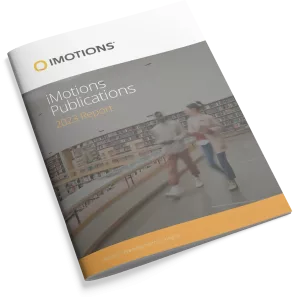-
Measuring Learning During Search: Differences in Interactions, Eye-Gaze, and Semantic Similarity to Expert Knowledge
Abstract: We investigate the relationship between search behavior, eye – tracking measures, and learning. We conducted a user study where 30 participants performed searches on the web. We measured their verbal knowledge before and after each task in a content-independent manner, by assessing the semantic similarity of their entries to expert vocabulary. We hypothesize that […] -
Measuring presence in video games: An investigation of the potential use of physiological measures as indicators of presence
Abstract: Presence has become an increasingly central component of Games User Research (GUR) as developments in technology continuously make modern video games more conducive to the sensation of ‘being there’ in virtual environments. The quality of games is now commonly evaluated based on how reliably they elicit presence; however, no standardized objective measure of presence […] -
How does navigation system behavior influence human behavior?
Abstract: Navigation systems are ubiquitous tools to assist wayfinders of the mobile information society with various navigational tasks. Whenever such systems assist with self-localization and path planning, they reduce human effort for navigating. Automated navigation assistance benefits navigation performance, but research seems to show that it negatively affects attention to environment properties, spatial knowledge acquisition, […] -
Using computer-vision and machine learning to automate facial coding of positive and negative affect intensity
Abstract: Facial expressions are fundamental to interpersonal communication, including social interaction, and allow people of different ages, cultures, and languages to quickly and reliably convey emotional information. Historically, facial expression research has followed from discrete emotion theories, which posit a limited number of distinct affective states that are represented with specific patterns of facial action. […] -
Moderating effects of prior brand usage on visual attention to video advertising and recall: An eye-tracking investigation
Abstract: For advertisers, attracting attention to video marketing stimuli is paramount to building and refreshing consumers’ brand memories and increasing their propensity to purchase. Research has demonstrated brand users are more likely to recall advertising, possibly suggesting a brand’s commercials draw more attention from current users than potential new customers. Testing whether prior brand usage […] -
Determining Consumer Preferences for Floral Design Elements
Floral designers have long been taught that the most important attributes of a floral design are the elements of line, color, texture, pattern, form, space, and size. Yet, little formal research has been conducted to determine which of these design elements are truly important to consumers and drive their purchasing behavior. This project, co-funded by […] -
Contrasting Divergent and Convergent Thinking by Electroencephalography and Eye Tracking
Abstract: The present study explores the adoption of electroencephalography and eye tracking to assess physiological differences between divergent and convergent thinking. In neuroscientific literature alpha power synchronization in the right parietal lobe has been associated to top-down inhibition of task-irrelevant cognitive processes occurring during divergent thinking, but findings in oculometric studies seem to suggest a […] -
Role of subjective and objective measures of cognitive processing during learning in explaining the spatial contiguity effect
Abstract: The main objective of this study was to investigate the potential of combining subjective and objective measures of learning process to uncover the mechanisms underlying the spatial contiguity effect in multimedia learning. The subjective measures of learning process were self-reported cognitive load ratings and the objective measures were eye-tracking and EEG measures. Learning outcome […] -
Traditional SETA No More: Investigating the Intersection Between Cybersecurity and Cognitive Neuroscience
Abstract: We investigated the role automated behavior plays in contributing to security breaches. Using different forms of phishing, combined with multiple neurophysiological tools, we were able to more fully understand the approaches participants took when they engaged with a phishing campaign. The four participants of this pilot study ranged in their individual characteristics of gender […] -
A Framework towards Quantifying Human Restorativeness in Virtual Built Environments
Abstract: The impact of built environment on the human restorativeness has long been argued; however, the interrelations between neuroscience and the built environment, and the degree to which the built environment contributes to increased human restorativeness has not been completely understood yet. Understanding the interrelations between neuroscience and the built environment is critical as 90% […]
Research Report 2024
In-depth look at the scientific landscape as powered by iMotions software, showcasing groundbreaking research and the impact of our tools in various scientific and industrial fields.

iMotions Science Resources
Looking for white papers, validation reports or research show casing iMotions Multimodal capabilities?
Share Your Research

850+ universities worldwide with an iMotions human behavior lab
73 of the top 100 highest ranked universities
710+ published research papers using iMotions
iMotions is used for some of the most interesting human behavior research studies carried out by top researchers around the world. Contact us to have your publication featured here.
The authors of these publications have used iMotions as a software tool within their research.
“Software should be cited on the same basis as any other research product such as a paper or a book; that is, authors should cite the appropriate set of software products just as they cite the appropriate set of papers” (Katz et al., 2020).
We therefore encourage you to cite the use of iMotions where appropriate.
How to cite iMotions
APA
iMotions (10), iMotions A/S, Copenhagen, Denmark, (2024).
Note: adjust the version and year where relevant.
5 Most Popular Blogs
Learn How to Conduct Human Behavior Research with iMotions
Publications
Read publications made possible with iMotions
Blog
Get inspired and learn more from our expert content writers
Newsletter
A monthly close up of latest product and research news

